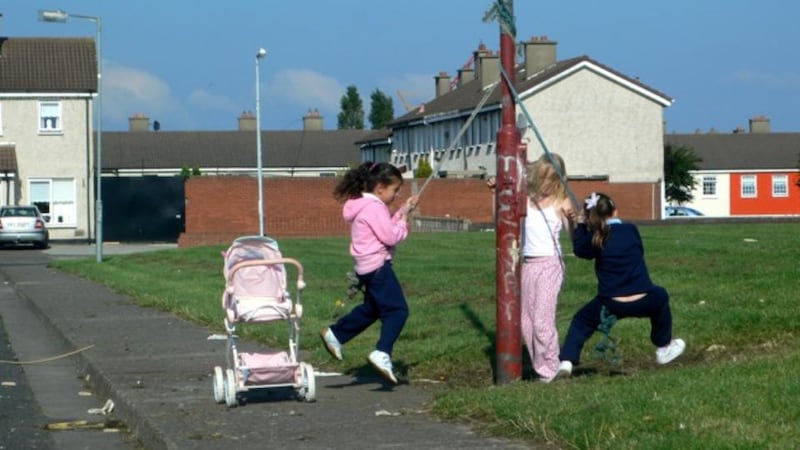Remember those far-off days when kids tied ropes to a lamp post and swung out of it? Mostly, they're either gone now or have been left in tatters as children have retreated indoors to their PlayStations and Xboxes, passing up on traditional outdoor play. "They don't make their own fun any more," Gregory Dunn says sadly.
Dunn has spent two years going around Dublin looking for lamp posts with ropes on them and taking photographs for an unusual Irish Architecture Foundation exhibition, The Everyday Experience, at the Irish Museum of Modern Art. Dunn's photographs now cover the space's end wall.
He got together with Urban Agency's Andrew Griffin and Maxim Laroussi to design a surprisingly strong tubular-steel frame, from which a seat is suspended on ropes. It is an architectural response to the absence of makeshift maypoles, and it could be replicated a hundred times in the city's green spaces.


Children are not allowed to swing on the seat for "health and safety" reasons. This also explains why there are no benches to sit on in a small room showing a 70- minute film of pilgrim routes in Mexico – because there is no fire-exit sign over the door.
This exhibition is not about architecture as we tend to think of it – "large monumental buildings created by well-known architects", as IAF director Nathalie Weadick puts it. There are no elaborate models, no flashy images of skyscrapers. Its aim is to "encourage us to think about how architecture impacts our daily lives".
Woven into everyday life
Weadick says her intention for the small exhibition was to "move away from the traditional focus on the look and construction of buildings, which is why I themed it The Everyday Experience. It is more about the impact and value, and how architecture – designed or informal – is immersed in the everyday, woven into everyday life."
Weadick, who was the curator at the Architecture Foundation in London, has made eclectic selections. “I chose the people because I am aware of their work and alternative practice, and I knew they could respond to the theme. The mixture of architects, artists, writers and film-makers shows the interdisciplinary nature of architecture,” she says.
Alex Milton, head of design at the National College of Art and Design, and designer Suzanne Martin, have collaborated to offer "souvenirs" of Dublin's north inner city, with marble-like models made using a 3D printer laid out on bakers' trays on top of a pram. They include a representation of the stump of Nelson's Pillar.
One of the largest installations is a highly geometric Bench for Networking, made by artist John Gerrard and A2 Architects. It was inspired by very strange and sinister landscape markings in China's Gobi desert measuring 1.5km by 1km, which are believed to be "focusing devices for spy satellites".
Gerrard visited the site six months ago and commissioned a high-resolution 3D image of the markings from a satellite scanning company in the US. Visitors may sit on the bench – a wifi zone – and use their smartphones, iPads, etc – bearing in mind that they might be tapped by the US National Security Agency.
"The everyday experience becomes one of a tacit acceptance of mass surveillance and personal data collection," Gerrard says, referring to the revelations by former NSA contract worker Edward Snowden, now in exile in Russia. "We know of the new architectures of surveillance being built around us, yet ignore them."
Cristian Manzutto and Derek Dellekamp made their film of the Ruta del Peregrino pilgrim route in Mexico to highlight how people have responded to a number of architectural installations placed along the route. By adding personal mementos, they turned these sculptural pieces into "something more meaningful and intimate".
Film about Achill-henge
Another film, by Tom de Paor and Peter Maybury, shown in a tiny room with a single oak chair, looks at the illegal Stonehenge-like structure built last year on Achill Island. Despite a public outcry from conservationists and an order by Mayo County Council to demolish it, the concrete structure – which the film- makers clearly admire – is still standing.
A third film by Paul Clarke and Conor McCafferty would be particularly interesting to architects and anyone who wonders how they work. It observes some of Ireland's best-known architects, such as Grafton and O'Donnell & Tuomey, in their daily practice, exploring how a bright idea eventually becomes a building.
Ciarán Ó Gaora invites us to peep through tiny holes in white boxes to squint at fuzzy images from his childhood, while Pablo Bronstein is showing three pieces of Chinese porcelain that may look Ming but are actually of no intrinsic value as a way of questioning "fashion, taste and the value we put on objects" such as handbags.
Evolution of a chair
More challenging is a tree and simple rustic chair, borrowed from the venerable Patrick Scott by Dominic Stevens, with the slogan: "A chair is a rearrangement of a hedgerow, beauty created by evolution rather than by individual genius" – a critical commentary on the value assigned to Eileen Gray's furniture, which is also now showing at Imma.
The exhibition – which also includes work by Celine Condorelli, Culturstruction and Renate Henschke, and Australian Aboriginal architect Kevin O'Brien – trails on Gray's coat-tails.
It includes a youth and education programme of special events. Architecture blogger Lisa Cassidy is also giving guided tours of Kilmainham, billed as An Ordinary Place, which will focus on themes such as sleep, washing and shelter in the vicinity of the Royal Hospital (more at architecturefoundation.ie).
The Everyday Experience is at Imma until January 26












